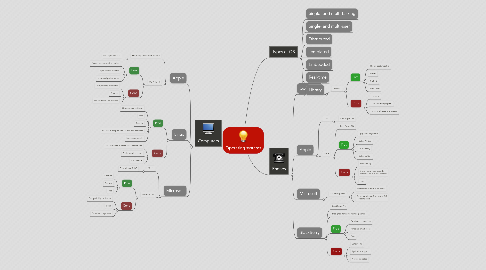
1. Computers
1.1. Apple
1.1.1. Rhapsody Developer Release
1.1.1.1. First Apple PC OS
1.1.2. OS X 10.11
1.1.2.1. Pros
1.1.2.1.1. Fastest version on the market
1.1.2.1.2. Split screen function
1.1.2.1.3. Improved performance
1.1.2.2. Cons
1.1.2.2.1. Compatibility problems
1.1.2.2.2. Crashes
1.1.2.2.3. Fail to detect usb devices
1.2. Linux
1.2.1. Pros
1.2.1.1. Open-source software
1.2.1.2. Free
1.2.1.3. Stability
1.2.1.4. Far less susceptible to viruses and malware
1.2.1.5. Super compatible
1.2.2. Cons
1.2.2.1. You can not run some MS applications
1.2.2.2. Slight learning curve
1.2.2.3. No support
1.3. Microsoft
1.3.1. Xenix
1.3.1.1. First Microsoft OS
1.3.2. Windows 10
1.3.2.1. Pros
1.3.2.1.1. Cortana
1.3.2.1.2. Security
1.3.2.1.3. Free
1.3.2.2. Cons
1.3.2.2.1. Compatibility problems
1.3.2.2.2. Bugs
1.3.2.2.3. Can't block updates
2. Phones
2.1. Google.inc
2.1.1. Android
2.1.1.1. Pros
2.1.1.1.1. Highly costumizable
2.1.1.1.2. Power
2.1.1.1.3. Stability
2.1.1.1.4. Low price
2.1.1.2. Cons
2.1.1.2.1. Freezing
2.1.1.2.2. Low pocessing speed
2.1.1.2.3. More malwares and viruses
2.2. Apple
2.2.1. OS X
2.2.1.1. First Apple OS
2.2.2. iOS 9
2.2.2.1. Last Apple OS
2.2.2.2. Pros
2.2.2.2.1. Upgraded kayboard
2.2.2.2.2. Better AI (Siri)
2.2.2.2.3. Ad blocking
2.2.2.2.4. Better battery
2.2.2.3. Cons
2.2.2.3.1. Fast heating
2.2.2.3.2. Slower download speed in comparison to older devices
2.2.2.3.3. Lags
2.3. Microsoft
2.3.1. Windows phone
2.3.1.1. Microsoft windows 8 or better
2.3.1.2. Same as Microsoft windows OS for computers
2.4. BlackBerry
2.4.1. BlackBerry OS
2.4.2. Designed for same named phones
2.4.3. Pros
2.4.3.1. Excellent connectivity
2.4.3.2. Amazing email client
2.4.3.3. Fast
2.4.4. Cons
2.4.4.1. Battery life
2.4.4.2. Aplication support
2.4.4.3. No big updates
